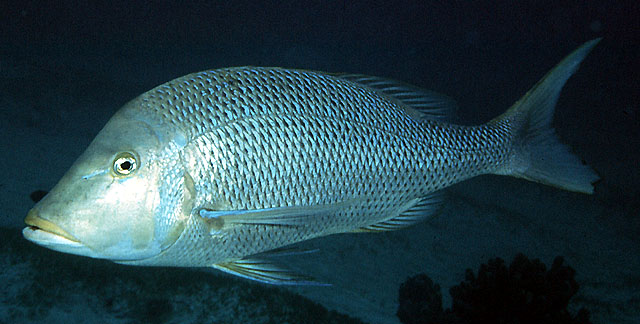| Lethrinidae (Emperors or scavengers), subfamily: Lethrininae |
| 87 cm TL (male/unsexed); max.weight: 8,400.0 g; max. reported age: 28 years |
|
reef-associated; depth range 10 - 75 m, non-migratory |
| Indo-West Pacific: Red Sea, Persian Gulf and East Africa to southern Japan and Samoa. According to a genetic study (Ref. 28017), Lethrinus nebulosus and Lethrinus choerorynchus are two distinct species in Western Australia. |
|
Dorsal spines (total): 10-10; Dorsal soft rays (total): 9-9; Anal spines: 3-3; Anal soft rays: 8-8. Cheek without scales; 5-9 scales in supra temporal patch; inner surface of pectoral fin densely covered with scales; posterior angle of opercular fully scaled. Body color is yellowish or bronze, lighter below. Centers of many scales with a white or light blue spot. Sometimes irregular dark indistinct bars on sides and a square black blotch above pectoral fin bordering below the lateral line. Three blue streaks or series of blue spots radiate forward and ventrally from the eye. The fins are whitish or yellowish; the pelvic dusky, the edge of the dorsal fin is reddish. TL/SL relationship (cm): TL = 1.70 +1.24. Juveniles variable with blotches or stripe and changes with habitat (Ref. 48635). |
| Inhabit coral reefs, coralline lagoons, seagrass beds, mangrove swamps, flat sand bottoms, and coastal rock areas. Adults solitary or in small schools; juveniles form large schools in shallow, sheltered sandy areas, also harbors where seagrasses, algae or sponge habitats are found at various depths. Feed on echinoderms, mollusks and crustaceans, and to some extent on polychaetes and fish. The reproductive nature of spangled emperors is uncertain, although they also may be protogynous hermaphrodites (Ref. 27260, 55367). However, recent study classified juvenile hermaphroditism for this species wherein transition from ovary to testis occurs before ovarian maturation, hence, no true sex-reversal in the sense of protogynous hermaphroditism is observed (Ref. 107020). May have a coppery or iodine taste or smell in the Indian Ocean (Ref. 2295, 11888). It has been shown that this species can survive for long periods in salinities as low as 10 parts per thousand and therefore it is a potential estuarine aquaculture species (Ref. 2295). Utilized as a food fish. |
|
(Ref. 96402)
|
| reports of ciguatera poisoning |
|
Source and more info: www.fishbase.org. For personal, classroom, and other internal use only. Not for publication.
Page created by Jen, 05.08.02,
php script by kbanasihan 06/09/2010 ,
last modified by
dsantos, 20/08/10

